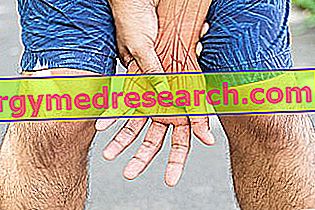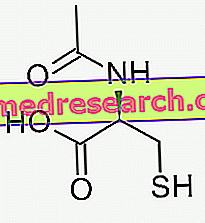Generality
Muscular dystrophies are genetic diseases, very often also hereditary, that weaken the muscles and reduce the motor skills of affected people.

Muscular dystrophies are triggered by one or more genetic mutations; the number of potentially responsible genes is high, according to several scientific studies, up to a hundred.
Hereditary muscular dystrophies can belong to the group of autosomal recessive diseases, dominant autosomal diseases or diseases linked to sexual chromosome X.
Of all the muscular dystrophies, the most common and known is Duchenne muscular dystrophy.
Recalls of genetics
Before describing muscular dystrophy, a brief reference to some key concepts is useful.
What is DNA? It is the genetic heritage in which the physical features, predispositions, physical qualities, character, etc. are written. of a living organism. It is contained in all the cells of the body having a nucleus, as it is inside this one.
What are chromosomes? According to the definition, chromosomes are the structural units in which DNA is organized. The human cells contain, in their nucleus, 23 pairs of homologous chromosomes (22 of an autosomal non-sexual type and a couple of sexual type); each pair is different from another, as it contains a specific gene sequence.
What are genes? They are short stretches, or sequences, of DNA with a fundamental biological meaning: from them, in fact, proteins are derived, that is, fundamental biological molecules for life. In genes, there is "written" part of what we are and what we will become.
Each gene is present in two versions, the alleles: an allele is of maternal origin, then transmitted by the mother; the other allele is of paternal origin, therefore transmitted by the father.
What is a genetic mutation? It is an error within the DNA sequence that forms a gene. Because of this error, the resulting protein is defective or completely absent. In both cases, the effects can be deleterious both for the life of the cell, in which the mutation occurs, and for that of the organism in its totality. Congenital diseases and neoplasms (or tumors) are responsible for one or more genetic mutations.
What is muscular dystrophy?
Muscular dystrophy is the term used to indicate a group of genetic diseases, very often also hereditary, which cause a gradual weakening of the muscles and a progressive disability.
The most common and common types of muscular dystrophy are:
- Duchenne Muscular Dystrophy
- Myotonic Dystrophy
- Facio-scapulo-humeral muscular dystrophy
- Becker Muscular Dystrophy
- The Muscular Dystrophies of the Tracks
- Oculopharyngeal Muscular Dystrophy
- Emery-Dreifuss Muscular Dystrophy
- Distal Muscular Dystrophies
Epidemiology
In the UK, more than 70, 000 people, children and adults, suffer from a type of muscular dystrophy.
The three most common muscular dystrophies are: Duchenne muscular dystrophy, which affects one male child every 3, 500 newborns; myotonic dystrophy, which affects one person every 8, 000; and facio-scapulo-humeral muscular dystrophy, which affects one person every 20, 000 (NB: the data refer to the United Kingdom).
In Italy, around 20, 000 people suffer from Duchenne muscular dystrophy.
Causes
A cause of muscular dystrophy is a mutation in one or more genes of fundamental importance for the correct development and proper functioning of the muscular apparatus.
In other words, muscular dystrophies are the result of one or more genetic alterations, which prevent the muscular apparatus from developing properly and functioning properly.
According to the scientific researches carried out so far, the genes involved in the appearance of muscular dystrophies are more than a hundred and the proteins they produce (when they are free of mutations) deal with building up the muscle fiber .
WHERE DOES GENETIC MUTATION ORIGINATE?
The genetic mutations responsible for muscular dystrophies are, more often than not, hereditary (ie transmitted by parents), but they can also be the result of spontaneous mutations that occur in the maternal oocyte or during embryonic development.
HEREDITARY MUSCULAR DISTROPHIES
Half of the chromosomes present in an individual come from the mother and the other half from the father.
If in one of these inherited chromosomes there is a mutation, the individual will carry it with him from conception and birth. It is with this mechanism that inherited genetic diseases arise.
The muscular dystrophies transmitted by the parents may belong to the category of:
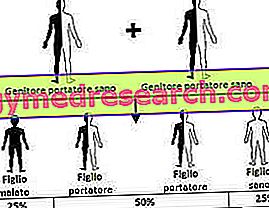
Figure: hereditary transmission of an autosomal recessive disease. Sex does not affect, as the genetic mutation resides on a non-sexual (or autosomal) chromosome.
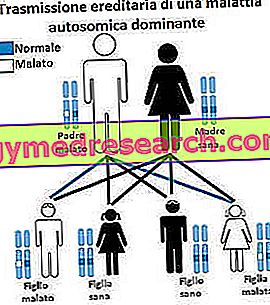
Figure: hereditary transmission of an autosomal dominant disease. Sex does not affect, as the genetic mutation resides on a non-sexual (or autosomal) chromosome.
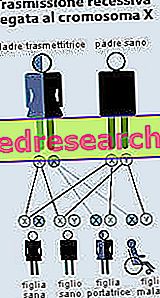
Figure: in hereditary diseases related to the X chromosome, a female can be healthy or healthy carrier, a male can be healthy or sick. Autosomal recessive inherited disorders (NB: the term autosomal is used for diseases that affect genes placed on non-sexual chromosomes). In order for these diseases to be manifest, the responsible gene must be changed in both its versions, that is both in its maternal allele and in its paternal one. In fact, the partial contribution of only one of the two parents is not enough to make the child (or daughter) sick.
In these cases, subjects with the responsible gene mutated only in one version (ie only in one allele) are called healthy carriers of the disease.
Examples of recessive muscular dystrophies are: some muscular dystrophies of the limbs and a subtype of Emery-Dreifuss muscular dystrophy.
- Autosomal dominant inherited disorders . For these diseases to be manifest, the mutation of only one version of the responsible gene is sufficient; it does not matter if the responsible allele is the maternal or paternal.
Examples of dominant muscular dystrophies are: myotonic dystrophy, facio-scapulohumeral muscular dystrophy, oculopharyngeal muscular dystrophy, a subtype of Emery-Dreifuss muscular dystrophy and some muscular dystrophies of the limbs.
- Hereditary diseases related to the sex chromosome X. A healthy man, in every cell, has a sex chromosome X and a sex chromosome Y; a healthy woman, on the other hand, has two X chromosomes.
A hereditary disease, whose characteristic genetic mutation resides in the X chromosome, implies that the man is sick and the woman is a healthy carrier (or, alternatively, suffering from a much milder form of the disease). This happens because the man does not have, in his cells, other X chromosomes that can replace the altered functions of the diseased X chromosome; on the contrary, in each cell, the woman is in possession of another healthy X chromosome, capable of supplying the altered functions of the mutated one.
Examples of muscular dystrophies related to sexual chromosome X are: Duchenne muscular dystrophy and Becker muscular dystrophy.
MUSCULAR DISTROPHIES CAUSED BY SPONTANEOUS MUTATIONS
It can happen that muscular dystrophies are caused by a spontaneous mutation of a gene that is fundamental for muscle health. This mechanism explains how, for example, male children of healthy women who do not carry the disease can also develop Duchenne muscular dystrophy.
Continue: Types of Muscular Dystrophy »




